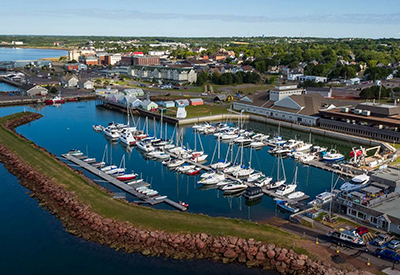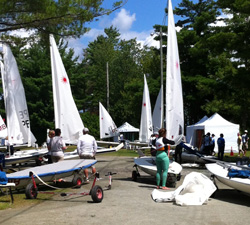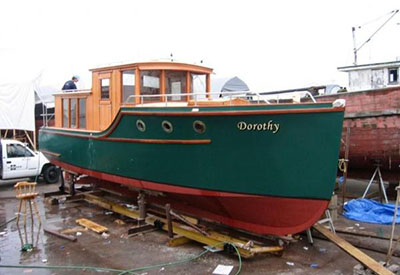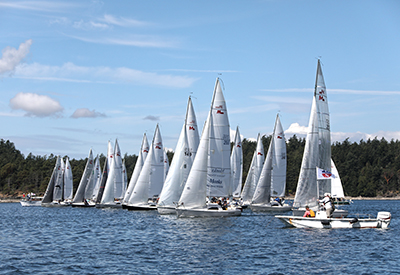Nanaimo Yacht Club
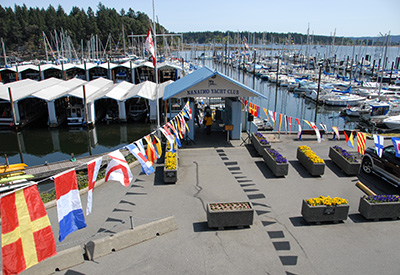
By Katherine Stone
For centuries the lure of the west coast brought settlers, immigrants, migrant workers, gold seekers, adventurers and entrepreneurs. Prior to their arrival the Coast Salish people named Snuneymuxw lived a life of luxury, fishing off the waters of the beautiful coastal harbour, gathering shellfish and having leisure time to create beautiful works of art using the surrounding pieces of their environment.
The first Europeans to arrive in 1791 were with the Spanish voyage of Juan Carrasco who named their town Bocas de Winthuysen and set up a trading post. When others arrived they referred to the town as Colevile. The Hudson Bay Company was given the rites to Vancouver Island in 1849 which also included the monies earned from mining. In 10 years’ time they would have to resell the island to the Crown -90% of their gain was to develop the colony and the remaining 10% could be kept by the company.
During those 10 years the Snuneymuxw Chief, Coal Tyee, presented a canoe load of excellent quality coal to the company, a bastion was built to protect the harbour, and a boatload of immigrants arrived from England. With a thriving white population of over 150 settlers, the town was renamed Nanaimo. It would later be nicknamed “The Hub City” due to the street layout design radiating out from the shoreline like the spokes of a wagon wheel. Today it is more popularly known as “The Harbour City”.
Nanaimo coal was king until the end of the 1930s when forestry became the major industry. Located on Vancouver Island, 110km north of Victoria, Nanaimo is the gateway to many other destinations. With a temperate climate of mild, rainy winters and cool, dry summers it is ideal for spending time on the water. It is well known as the “Bathtub Racing Capital of the World” and is home to North America’s first legal, purpose-made bungee jumping bridge… adventurers unite!
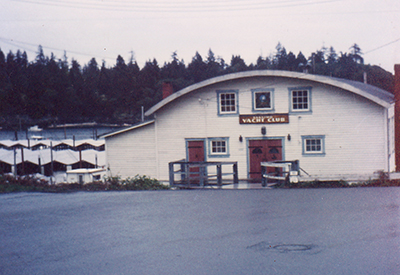 In the late 1800s, much leisure time was devoted to water activities and many attempts were made to form a club that would promote these activities. It wasn’t until the summer of 1931 that the Nanaimo Yacht Club was formed to promote power boat racing. The following year they hosted the International Speedboat Regatta which really gave the club incentive to expand. “Their first meeting was held in the parlour of a funeral home where it was decided to rent Anderson’s Boat House for a clubhouse in the area near the Port Theatre,” said Commodore Pat Grounds…. I guess there was no one around to object! All went well and the following year land was procured, cleared and the members set about building docks. An old building was donated, torn down and the lumber used to erect the first clubhouse which would set the foundations for all future buildings, located at the south end of Newcastle Channel.
In the late 1800s, much leisure time was devoted to water activities and many attempts were made to form a club that would promote these activities. It wasn’t until the summer of 1931 that the Nanaimo Yacht Club was formed to promote power boat racing. The following year they hosted the International Speedboat Regatta which really gave the club incentive to expand. “Their first meeting was held in the parlour of a funeral home where it was decided to rent Anderson’s Boat House for a clubhouse in the area near the Port Theatre,” said Commodore Pat Grounds…. I guess there was no one around to object! All went well and the following year land was procured, cleared and the members set about building docks. An old building was donated, torn down and the lumber used to erect the first clubhouse which would set the foundations for all future buildings, located at the south end of Newcastle Channel.
In following years the docks would be expanded, breakwaters installed and covered moorage built by 1967. Sailboats started to become a larger part of club activities with the establishment of the comet fleet, followed by the Sabot fleet and finally the Thunderbird fleet in 1971. The clubhouse was rebuilt in 1977 with a gatehouse, walkway and landscaping. By the end of the 1900s, new moorage spaces were added to bring the harbour accommodation to over 370 boats. By leasing an 80 foot dock at the Silva Bay Resort and Marina on Gabriola Island, they have also provided an Outstation. The tradition of club member participation in the upkeep of the club amenities has continued to this day and is a key part of the success of the NYC. With over 750 active volunteer members, this has certainly helped! “We’re always trying to attract members. The misconception of the club from 10 years ago, or 13 when I joined it, was a long wait to get moorage. We no longer have the long waits that used to be looked at – 10 year waits for moorage are just unheard of now,” relates club Staff Captain, Jim Goehringer.
 As is important for every boating club, innovation with membership offerings and programs is an integral part of the club’s longevity. The sailing program offers CANSail levels 1-6 and Opti Wet Feet programs, but also “Try it” sessions for those not sure if they want to commit to a full program and Drop-in Practice sessions to hone in on your skills. The Recreational Dinghy Sailing sessions offer opportunity to sail in a purely supportive and safe environment. The Dinghy Sailing and Development Race teams have a focus on “fun with a purpose” offering mental training, physical fitness and competition. Nanaimo YC has also partnered with the International Yacht Training program (offered in 40 other countries). This program offers recreational sailing courses through to Master of Yachts certification for commercial vessels.
As is important for every boating club, innovation with membership offerings and programs is an integral part of the club’s longevity. The sailing program offers CANSail levels 1-6 and Opti Wet Feet programs, but also “Try it” sessions for those not sure if they want to commit to a full program and Drop-in Practice sessions to hone in on your skills. The Recreational Dinghy Sailing sessions offer opportunity to sail in a purely supportive and safe environment. The Dinghy Sailing and Development Race teams have a focus on “fun with a purpose” offering mental training, physical fitness and competition. Nanaimo YC has also partnered with the International Yacht Training program (offered in 40 other countries). This program offers recreational sailing courses through to Master of Yachts certification for commercial vessels.
Not only have they been innovative with their program offerings and events, but also with the naming of them. There’s the Day and a Bit Race, Symphony Splash, Ladysmith Dinner Cruise, Silly Boat Race and the Bathtub weekend. …. humm, do you suppose they are in these bathtubs when they are afloat? Getting involved in the community, they have initiated and organized the Community Christmas Light Cruise, the Interclub Corn Roast, Kayak/Paddle Evenings and the Fish & Game Cruise for the visually impaired. Added to these are the standard spring, summer, fall and single handed series. Their annual signature Snake Island Nanaimo Regatta was renamed this year to honour a long standing member, Basil Hobbs. Basil worked tirelessly behind the scenes and in leadership roles on behalf of marine safety and security to aid the professional and recreational mariner.
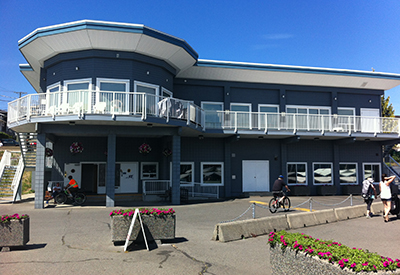 Long time, active NYC and Power Squadron member, Norman Nummela, embodies the epitome of the ethos of the club when he decided to get into boating. Not having a pocketful of money and working with a lot of moxie, he visited the Spencer Craft Boat operation in Vancouver. From a drawing he received while at the business, he thought he could build a boat himself. He made a table from a scale provided on the drawing. He and his wife then made the calculations and laid them all out on the kitchen table. He didn’t know much about marine architecture so he got a book from the library for reference.
Long time, active NYC and Power Squadron member, Norman Nummela, embodies the epitome of the ethos of the club when he decided to get into boating. Not having a pocketful of money and working with a lot of moxie, he visited the Spencer Craft Boat operation in Vancouver. From a drawing he received while at the business, he thought he could build a boat himself. He made a table from a scale provided on the drawing. He and his wife then made the calculations and laid them all out on the kitchen table. He didn’t know much about marine architecture so he got a book from the library for reference.
The next 10 years were consumed with building a 44 foot wooden powerboat on his front yard. He salvaged most of the materials, using yellow cedar chips to form the hull and topsides. Finally, in 1978 the boat was launched and christened, Kanaka Girl (Hawaiian for “human being”) and he and his family cruised almost the entire northwest coast from Lake Washington and Olympia up to Glacier Bay. Her log book is full of all the many people that crewed aboard. When the family grew up and moved away, all his maintenance personnel disappeared. As we all know, a wooden boat is a labour of love that entails a great deal of upkeep. So when he decided to stop boating after 37 years, he realized that he wanted to dismantle and recycle the Kanaka Girl. He didn’t want it on his conscience that it would become a derelict live-a-board which would break his and his family’s heart. When the commodore told him that what he had done was a “class act” it made him feel good that he had done the right thing.
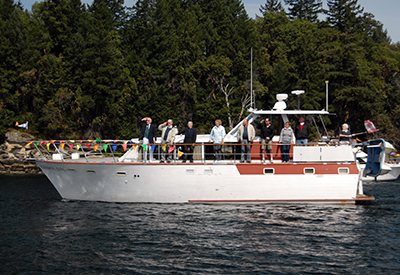 The lure of the west coast also “stung” Sea Salt author/galley cook, Lorna Malone who moved from Ontario to Nanaimo in the late 1970s. She single-handedly planned meals for eight crew members aboard their wooden boat, Aeriel, a McCurdy & Rhodes design during the grueling Van Isle 360 International Yacht Race which circumnavigates Vancouver Island and can take up to two weeks. This race runs every two years and will commence in Nanaimo in June 2017 and end in Victoria. I’m sure that many of the NYC members will not only volunteer their time to help out but also participate in this event. It is often referred to as the “bloody, bruising, dangerous, all consuming best race on the Pacific Northwest Coast”.
The lure of the west coast also “stung” Sea Salt author/galley cook, Lorna Malone who moved from Ontario to Nanaimo in the late 1970s. She single-handedly planned meals for eight crew members aboard their wooden boat, Aeriel, a McCurdy & Rhodes design during the grueling Van Isle 360 International Yacht Race which circumnavigates Vancouver Island and can take up to two weeks. This race runs every two years and will commence in Nanaimo in June 2017 and end in Victoria. I’m sure that many of the NYC members will not only volunteer their time to help out but also participate in this event. It is often referred to as the “bloody, bruising, dangerous, all consuming best race on the Pacific Northwest Coast”.
The lure of the west coast is calling your name. You could move there like Lorna, make it your home like Norman and Jim, or just visit for the scenery and solitude…as my husband and I have done. As Jim likes to point out, “We have the best reciprocal moorage facility in the Pacific Northwest, with over 400 feet of designated moorage for reciprocal yacht club moorage and over 1500 boats that use this each year. We love to have visitors stop for a few days and enjoy the charm of Nanaimo Harbour.”
It’s your choice, but one you’ll never forget!
Nanaimo Yacht Club; 400 Newcastle Avenue; Nanaimo, BC V9S 4J1; 250-754-7224;
www.nanaimoyc.ca
nyc@nanaimoyc.ca
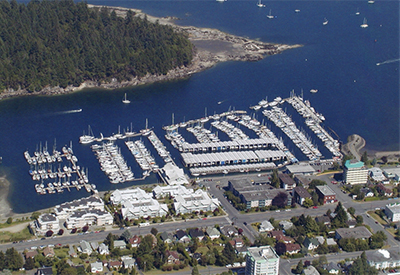 Photo Captions:
Photo Captions:
Photo 1 – Looking at the marina basin from the clubhouse with all of its colours.
Photo 2 – The original clubhouse.
Photo 3 – The first mooring basin with all of the power boats.
Photo 4 – The clubhouse all decked out for its members.
Photo 5 – Norman Numela’s 44 foot power cruiser, Kanata Girl, built on his front lawn over 10 years.
Photo 6 – Aerial shot of the harbour.

